Predicting Soil Saturated Water Conductivity Using Pedo-Transfer Functions for Rocky Mountain Forests in Northern China
Abstract
:1. Introduction
2. Materials and Methods
2.1. Study Area
2.2. Plot Selection
2.3. Soil Sample Collection
2.4. Determination of Ks
2.5. Industrial CT Scanning and 3D Soil Structure Determination
2.6. Evaluation of PTF Models
2.7. Data Processing
3. Results
3.1. Ks in Different Forest Soils
3.2. Relationships between Soil Physicochemical Properties of Different Forest Types on Ks
3.3. Characteristics of Soil Macropore Structure and Effect on Ks
3.4. Construction of PTFs Model for Ks
4. Discussion
4.1. Characteristics of Ks and Its Influencing Factors
4.2. Applicability of PTFs to Predict Ks
5. Conclusions
- (1)
- Observed Ks of typical forest soil in rocky mountain areas of Northern China showed an overall decrease with depth, and the relation coniferous < broadleaf < mixed forest. The variation in mixed forests was greater than that of pure forests, especially in the surface layer (0–10 cm) of soil, where the Ks of mixed forests was significantly greater than that of pure forests.
- (2)
- For soil physicochemical properties, organic matter (p < 0.001), total nitrogen (p < 0.001), total potassium (p < 0.001), water content (p < 0.01), silt (p < 0.05), and total phosphorus (p < 0.05) were significantly positively correlated with Ks, while bulk density (p < 0.001) and sand (p < 0.05) were significantly negatively correlated with Ks. Moreover, both forest type and soil depth had certain effects on soil physicochemical properties, thereby affecting soil Ks.
- (3)
- The number density, length density, surface area density, and volume density of soil macropore structure showed a decreasing trend with increasing soil depth, and they were all significantly positively correlated with Ks (p < 0.001). The parameters of macropore spatial structure were significantly positively inter-correlated (p < 0.001).
- (4)
- The PTF2 (GMER = 0.924, RMSE = 0.878, AIC = 125.647) constructed by soil bulk density, organic matter, and total phosphorus was the best and most applicable among the three investigated PTFs. The prediction results of the three new PTFs were better than previously presented PTF models (Cosby, Campbell, Vereecken, and Julià).
- (5)
- Prediction of Ks using only parameters of macropore spatial structure did not provide satisfactory results. However, it may provide new ideas for future improved Ks PTFs. In the future, other soil structural parameters obtained by CT scanning can be considered to improve the accuracy of the prediction model.
Author Contributions
Funding
Data Availability Statement
Conflicts of Interest
References
- Hou, G.R.; Bi, H.X.; Wei, X.; Zhou, Q.Z.; Kong, L.X.; Wang, J.S.; Jia, J.B. Water conservation function of litters and soil in three kinds of woodlands in gully region of Loess Plateau. J. Soil Water Conser. 2018, 32, 357–363+371. [Google Scholar] [CrossRef]
- Parchami-Araghi, F.; Mirlatifi, S.M.; Dashtaki, S.G.; Mahdian, M.H. Point estimation of soil water infiltration process using Artificial Neural Networks for some calcareous soils. J. Hydrol. 2013, 481, 35–47. [Google Scholar] [CrossRef]
- Ghorbani-Dashtaki, S.; Homaee, M.; Loiskandl, W. Towards using pedotransfer functions for estimating infiltration parameters. Hydrol. Sci. J. 2016, 61, 1477–1488. [Google Scholar] [CrossRef] [Green Version]
- Xu, C.C.; Xu, X.L.; Liu, M.X.; Liu, W.; Yang, J.; Luo, W.; Zhang, R.F.; Kiely, G. Enhancing pedotransfer functions (PTFs) using soil spectral reflectance data for estimating saturated hydraulic conductivity in southwestern China. Catena 2017, 158, 350–356. [Google Scholar] [CrossRef]
- Klute, A.; Dirksen, C. Hydraulic conductivity and diffusivity: Laboratory methods. In Methods of Soil Analysis: Part 1—Physical and Mineralogical Methods; American Society of Agronomy—Soil Science Society of America: Madison, WI, USA, 1986; Volume 5, pp. 687–734. [Google Scholar] [CrossRef]
- Zhu, P.Z.; Zhang, G.H.; Zhang, B.J. Soil saturated hydraulic conductivity of typical revegetated plants on steep gully slopes of Chinese Loess Plateau. Geoderma 2022, 412, 115717. [Google Scholar] [CrossRef]
- Germann, P.F.; Beven, K. Kinematic wave approximation to infiltration into soils with sorbing macropores. Water Resour. Res. 1985, 21, 990–996. [Google Scholar] [CrossRef]
- Watson, K.W.; Luxmoore, R.J. Estimating macroporosity in a forest watershed by use of a tension infiltrometer†. Soil Sci. Soc. Am. J. 1986, 50, 578–582. [Google Scholar] [CrossRef]
- Hayashi, Y.; Ken’ichirou, K.; Mizuyama, T. Changes in pore size distribution and hydraulic properties of forest soil resulting from structural development. J. Hydrol. 2006, 331, 85–102. [Google Scholar] [CrossRef]
- Soto-Gómez, D.; Pérez-Rodríguez, P.; Vázquez-Juiz, L.; Lopez-Periago, J.E.; Paradeloa, M. Linking pore network characteristics extracted from CT images to the transport of solute and colloid tracers in soils under different tillage managements. Soil Tillage Res. 2018, 177, 145–154. [Google Scholar] [CrossRef]
- Yang, Y.H.; Wu, J.C.; Zhao, S.W.; Han, Q.Y.; Pan, X.Y.; He, F.; Chen, C. Assessment of the responses of soil pore properties to combined soil structure amendments using X-ray computed tomography. Sci. Rep. 2018, 8, 695. [Google Scholar] [CrossRef] [Green Version]
- Katuwal, S.; Norgaard, T.; Moldrup, P.; Lamandé, M.; Wildenschild, D.; de Jonge, L.W. Linking air and water transport in intact soils to macropore characteristics inferred from X-ray computed tomography. Geoderma 2015, 237–238, 9–20. [Google Scholar] [CrossRef]
- Larsbo, M.; Koestel, J.; Jarvis, N. Relations between macropore network characteristics and the degree of preferential solute transport. Hydrol. Earth Syst. Sci. 2014, 18, 5255–5269. [Google Scholar] [CrossRef] [Green Version]
- Li, J.Z.; Pei, T.F.; Li, X.Y.; Niu, L.H. Models of soil saturated infiltration coefficient and effective porosity in forest catchment. Chin. J. Appl. Ecol. 1998, 6, 597–602. Available online: http://www.cjae.net/CN/abstract/abstract4925.shtml (accessed on 18 December 1998).
- Shi, Z.J.; Wang, Y.H.; Xu, L.H.; Xiong, W.; Yu, P.T.; Guo, H.; Xu, D.P. The influence of rock fragments on the characteristics of macropore and water effluent of forest soils in the Liupan Mountains, Northwest China. Acta Ecol. Sin. 2008, 10, 4929–4939. [Google Scholar] [CrossRef]
- Wang, Z.W.; Shao, M.A.; Huang, L.M.; Pei, Y.W.; Li, R.L. Distribution and Influencing Factors of Soil Saturated Hydraulic Conductivity Under Different Land Use Patterns in Eastern Qinghai Province. J. Soil Water Conser. 2021, 35, 150–155. [Google Scholar] [CrossRef]
- Zheng, H.; Han, L.; Shojaaddini, A. Predicting saturated hydraulic conductivity by pedo-transfer function and spatial methods in calcareous soils. J. Appl. Geophys. 2021, 191, 104367. [Google Scholar] [CrossRef]
- Koestel, J.K. Links between soil properties and steady-state solute transport through cultivated topsoil at the field scale. Water Resour. Res. 2013, 49, 790–807. [Google Scholar] [CrossRef] [Green Version]
- Baver, L.D. Soil permeability in relation to non-capillary porosity. Soil Sci. Soc. Am. J. 1939, 3, 52–56. [Google Scholar] [CrossRef] [Green Version]
- Liu, S.Z.; Wang, Y.Q.; An, Z.S.; Sun, H.; Zhang, P.P.; Zhao, Y.L.; Zhou, Z.X.; Xu, L.; Zhou, J.X.; Qi, L.J. Watershed spatial heterogeneity of soil saturated hydraulic conductivity as affected by landscape unit in the critical zone. Catena 2021, 203, e105322. [Google Scholar] [CrossRef]
- Becker, R.; Gebremichael, M.; Märker, M. Impact of soil surface and subsurface properties on soil saturated hydraulic conductivity in the semi-arid Walnut Gulch Experimental Watershed, Arizona, USA. Geoderma 2018, 322, 112–120. [Google Scholar] [CrossRef]
- Fang, L.J.; Gao, R.Z.; Liu, T.X.; Zhang, A.L.; Wang, X.X. Construction and evaluation of pedo-transfer functions in the Balager River Basin. Arid Zone Res. 2020, 37, 1156–1165. [Google Scholar] [CrossRef]
- Schaap, M.G.; Leij, F.J.; van Genuchten, M.T. Neural network analysis for hierarchical prediction of soil hydraulic properties. Soil Sci. Soc. Am. J. 1998, 62, 847–855. [Google Scholar] [CrossRef]
- Minasny, B.; McBratney, A.B. Evaluation and development of hydraulic conductivity pedotransfer functions for Australian soil. Soil Res. 2000, 38, 905–926. [Google Scholar] [CrossRef]
- Minasny, B.; Mcbratney, A.B. The neuro-m method for fitting neural network parametric pedotransfer functions. Soil Sci. Soc. Am. J. 2002, 66, 352–361. [Google Scholar] [CrossRef] [Green Version]
- Yang, S.E.; Huang, Y.F. Prediction of soil hydraulic characteristic parameters based on support vector machine. Trans. Chin. Soc. Agric. Eng. 2007, 7, 42–47. [Google Scholar] [CrossRef]
- Meng, C.; Niu, J.Z.; Li, X.; Luo, Z.T.; Du, X.Q.; Du, J.; Lin, X.N. Quantifying soil macropore networks in different forest communities using industrial computed tomography in a mountainous area of North China. J. Soils Sediments 2017, 17, 2357–2370. [Google Scholar] [CrossRef]
- Nachtergaele, F.; Velthuizen, H.V.; Verelst, L.; Batjes, N.H.; Dijkshoorn, K.; van Engelen, V.W.P.; Fischer, G.; Jones, A.; Montanarella, L.; Petri, M.; et al. The harmonized world soil database. In Proceedings of the 19th World Congress of Soil Science, Soil Solutions for a Changing World, Brisbane, Australia, 1–6 August 2010; pp. 34–37. [Google Scholar]
- Wu, H.S.; Chen, X.M.; Chen, C. Study on Macropore in Main Paddy Soils in Tai-Lake Region with CT. J. Soil Water Conser. 2007, 02, 175–178. [Google Scholar] [CrossRef]
- Meng, C.; Niu, J.Z.; Yin, Z.C.; Luo, Z.T.; Lin, X.N.; Jia, J.W. Characteristics of rock fragments in different forest stony soil and its relationship with macropore characteristics in mountain area, northern China. J. Mt. Sci. 2018, 15, 519–531. [Google Scholar] [CrossRef]
- Luo, Z.T. Features of Preferential Flow and Its Influence Factors in Typical Forests Root Zone in Rocky Mountain Area of Northern China; Beijing Forestry University: Beijing, China, 2020; 103p. [Google Scholar] [CrossRef]
- Zhang, Z.F.; Zhang, X.Z. Effects of vegetation restoration on soil physical parameters on the Loess Plateau: A meta-analysis based on published data. Prog. Geogr. 2021, 40, 1012–1025. [Google Scholar] [CrossRef]
- Hao, H.X.; Wei, Y.J.; Cao, D.N.; Guo, Z.L.; Shi, Z.H. Vegetation restoration and fine roots promote soil infiltrability in heavy-textured soils. Soil Tillage Res. 2020, 198, 104542. [Google Scholar] [CrossRef]
- De Baets, S.; Poesen, J.; Knapen, A.; Barberá, G.G.; Navarro, J. Root characteristics of representative Mediterranean plant speciesand their erosion-reducing potential during concentrated runoff. Plant Soil 2007, 294, 169–183. [Google Scholar] [CrossRef]
- Lu, J.; Zhang, Q.; Werner, A.D.; Li, Y.; Jiang, S.; Tan, Z. Root-induced changes of soil hydraulic properties–A review. J. Hydrol. 2020, 589, 125203. [Google Scholar] [CrossRef]
- Godoy, V.A.; Zuquette, L.V.; Gómez-Hernández, J.J. Spatial variability of hydraulic conductivity and solute transport parameters and their spatial correlations to soil properties. Geoderma 2019, 339, 59–69. [Google Scholar] [CrossRef]
- Gao, P.F.; Ran, Z.L.; Han, Z.; Li, J.W.; Li, L.T.; Wei, C.F. Hydraulic properties and saturated hydraulic conductivity pedo-transfer function of rocky purple soil. Acta Pedol. Sin. 2021, 58, 128–139. [Google Scholar] [CrossRef]
- Huang, W.X.; Deng, Y.S.; Xie, F.Q.; Yang, G.R.; Jiang, D.H.; Huang, Z.G. Characteristics of soil saturated hydraulic conductivity on different positions and their controlling factors of granite collapsing gullies. Chin. J. Appl. Ecol. 2020, 31, 2431–2440. [Google Scholar] [CrossRef]
- Liu, M.X.; Wu, D.; Wu, S.P.; Liao, L.J. Characteristic of soil macropores under various types of forest coverage and their influence on saturated hydraulic conductivity in the Three Gorges Reservoir Area. Acta Ecol. Sin. 2016, 36, 3189–3196. [Google Scholar] [CrossRef]
- Wang, Z.L.; Zhao, Y.G.; Zhao, S.W.; Huang, J.H.; Du, C.; Ying, N.S. Study on soil saturated hydraulic conductivity and its influencing factors in typical grassland of farmland conversion. Acta Agrestia Sin. 2016, 24, 1254–1262. [Google Scholar] [CrossRef]
- Walkley, A.; Black, I.A. An examination of the Degtjareff method for determining soil organic matter, and a proposed modification of the chromic acid titration method. Soil Sci. 1934, 37, 29–38. [Google Scholar] [CrossRef]
- Hu, X.; Li, X.Y.; Li, Z.C.; Gao, Z.; Wu, X.C.; Wang, P.; Lyu, Y.L.; Liu, L.Y. Linking 3-D soil macropores and root architecture tonear saturated hydraulic conductivity of typical meadow soil types in the Qinghai Lake Watershed, northeastern Qinghai–TibetPlateau. Catena 2020, 185, 104287. [Google Scholar] [CrossRef]
- Pierret, A.; Capowiez, Y.; Belzunces, L.; Moran, C. 3D reconstruction and quantification of macropores using X-ray computedtomography and image analysis. Geoderma 2002, 106, 247–271. [Google Scholar] [CrossRef]
- Luo, L.; Lin, H.; Halleck, P. Quantifying soil structure and preferential flow in intact soil using X-ray computed tomography. Soil Sci. Soc. Am. J. 2008, 72, 1058–1069. [Google Scholar] [CrossRef] [Green Version]
- Jarvis, N.J.; Moeys, J.; Koestel, J.; Hollis, J.M. Preferential flow in a pedological perspective. In Hydropedology: Synergistic Integration of Soil Science and Hydrology; Henry, L., Ed.; Elsevier: Amsterdam, The Netherlands, 2012; Chapter 3; pp. 75–120. [Google Scholar] [CrossRef]
- Cosby, B.J.; Hornberger, G.M.; Clapp, R.B.; Ginn, T.R. A statistical exploration of the relationships of soil moisture characteristics to the physical properties of soils. Water Resour. Res. 1984, 20, 682–690. [Google Scholar] [CrossRef] [Green Version]
- Campbell, G.S.; Shiozawa, S. Prediction of hydraulic properties of soils using particle-size distribution and bulk density data. In Proceedings of the International Workshop on Indirect Methods for Estimating the Hydraulic Properties of Unsaturated Soils; van Genuchten, M.T., Leij, F.J., Lund, L.J., Eds.; University of California: Riverside, CA, USA, 1992; pp. 317–328. [Google Scholar]
- Vereecken, H.; Maes, J.; Feyen, J. Estimating unsaturated hydraulic conductivity from easily measured soil properties. Soil Sci. 1990, 149, 1–12. [Google Scholar] [CrossRef]
- Julià, M.F.; Monreal, T.E.; Jimenez, A.S.D.C.; Melendez, E.G. Constructing a saturated hydraulic conductivity map of Spain using pedotransfer functions and spatial prediction. Geoderma 2004, 123, 257–277. [Google Scholar] [CrossRef]

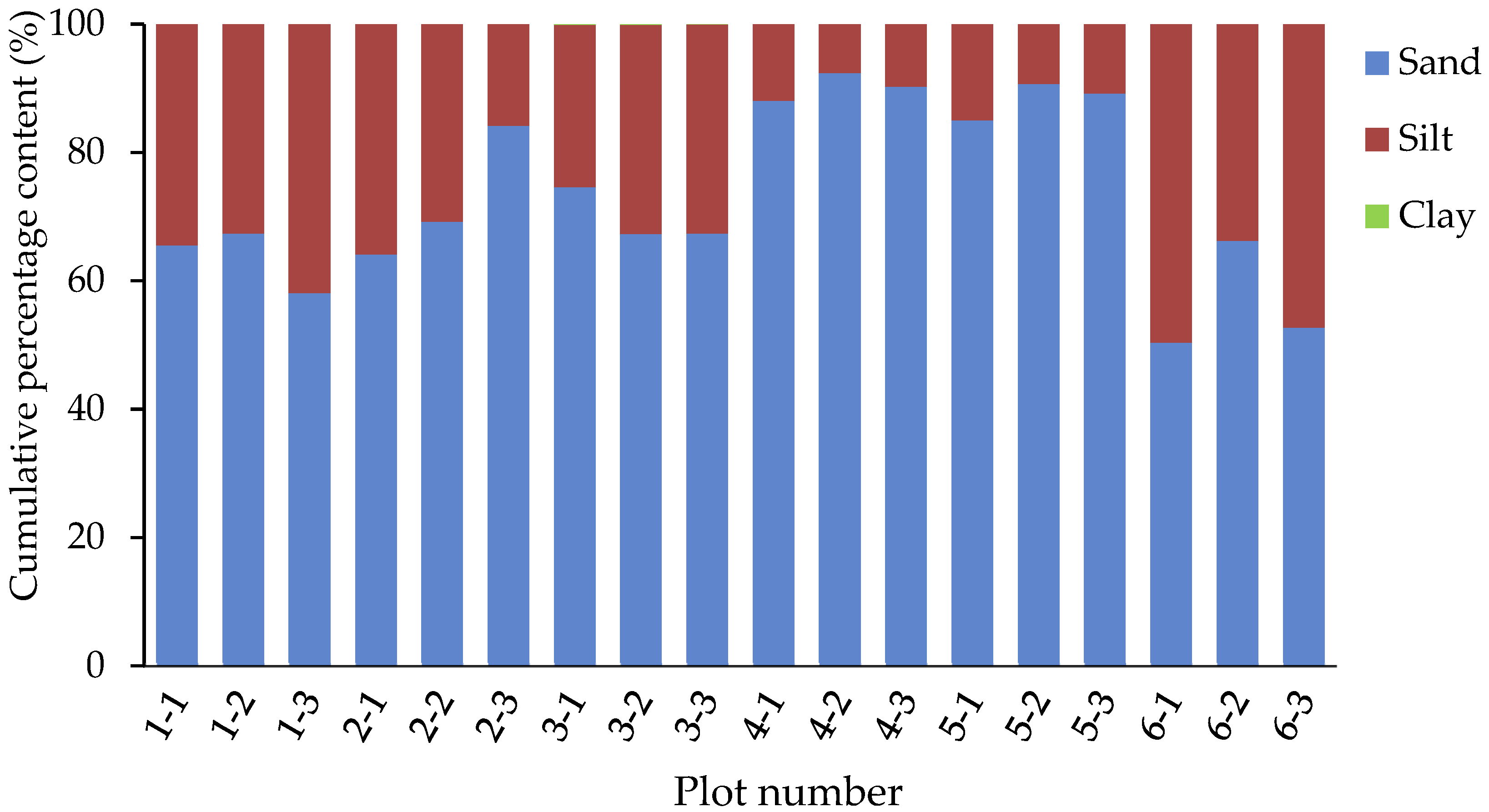

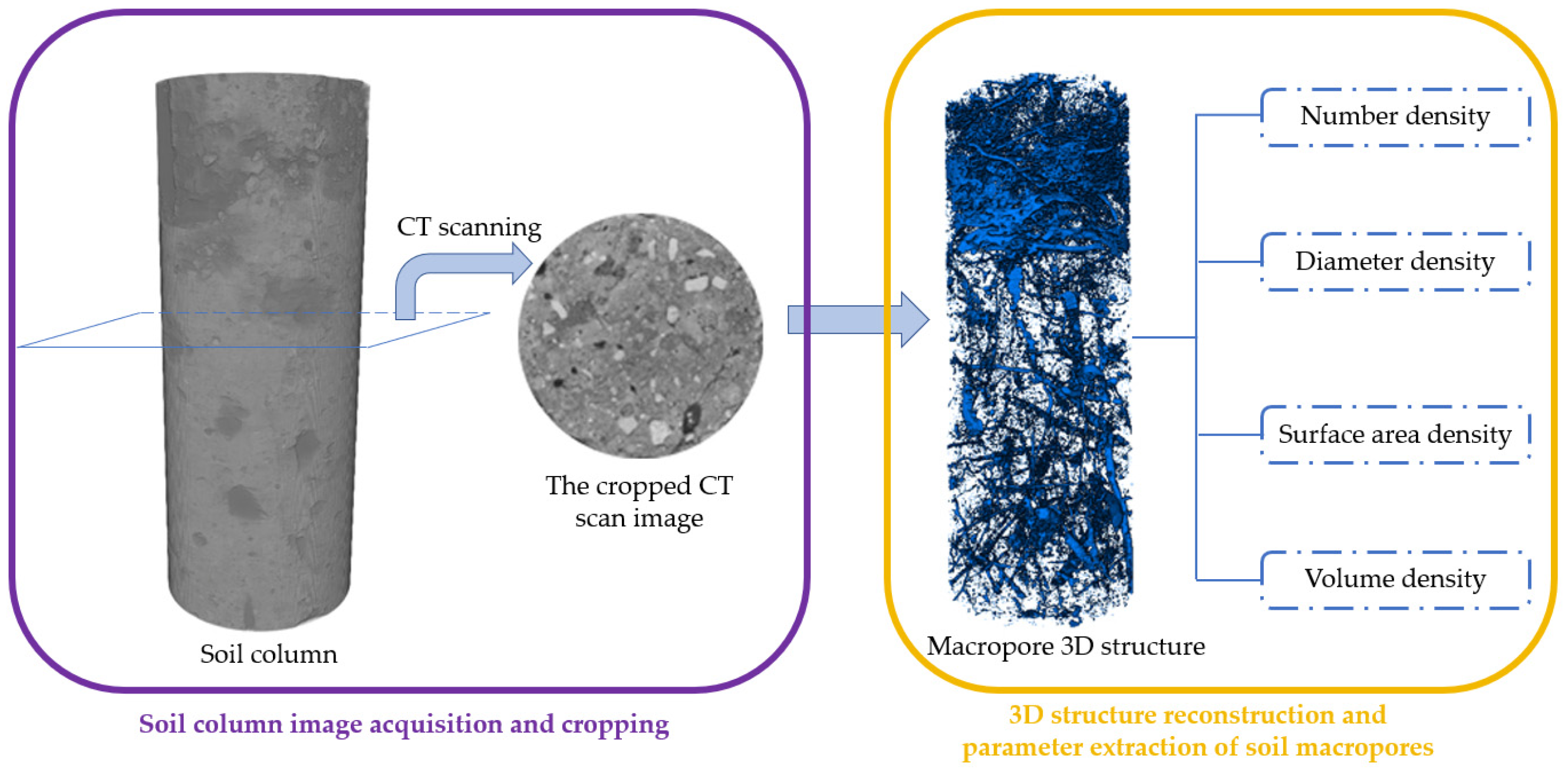

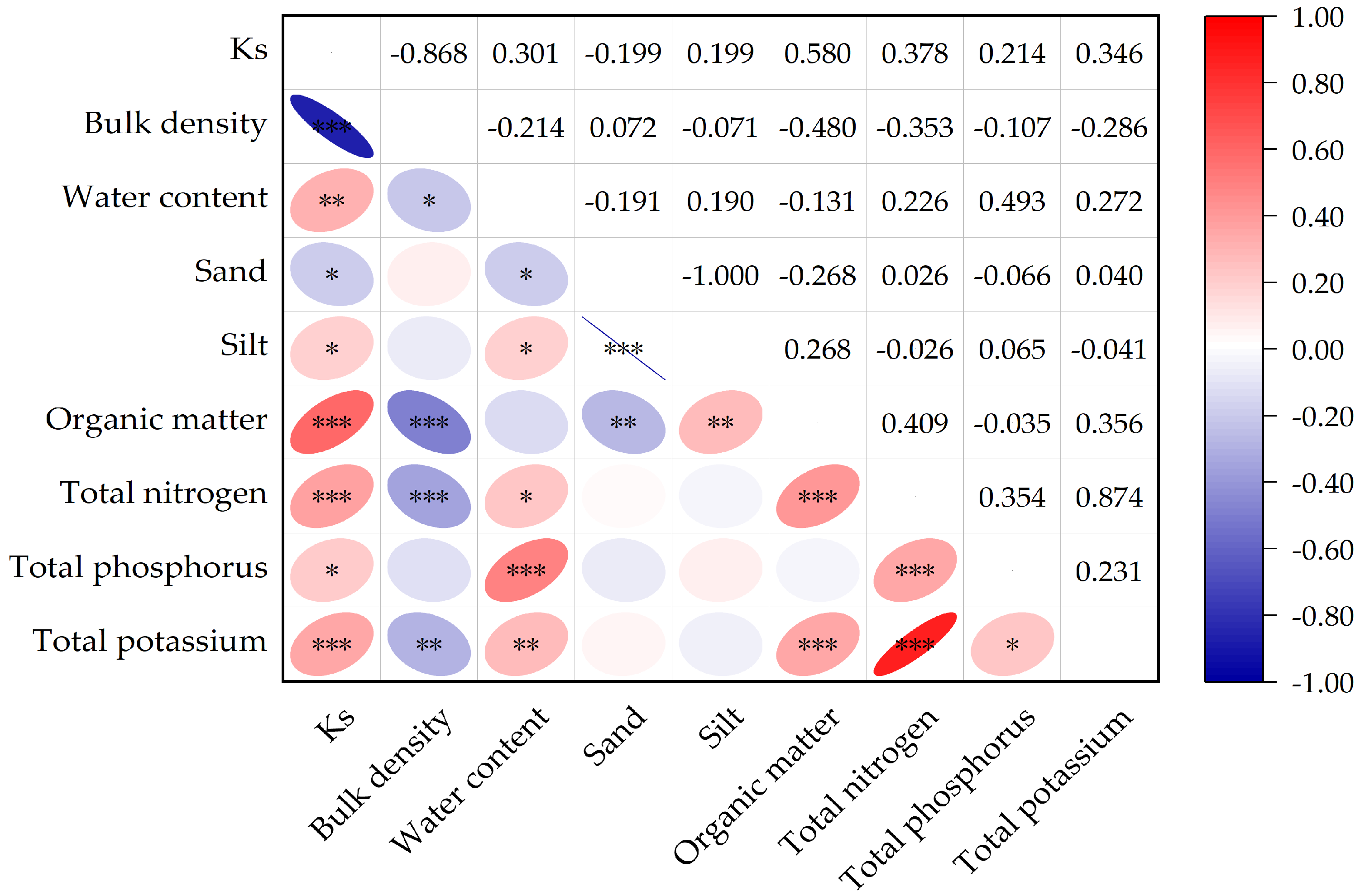
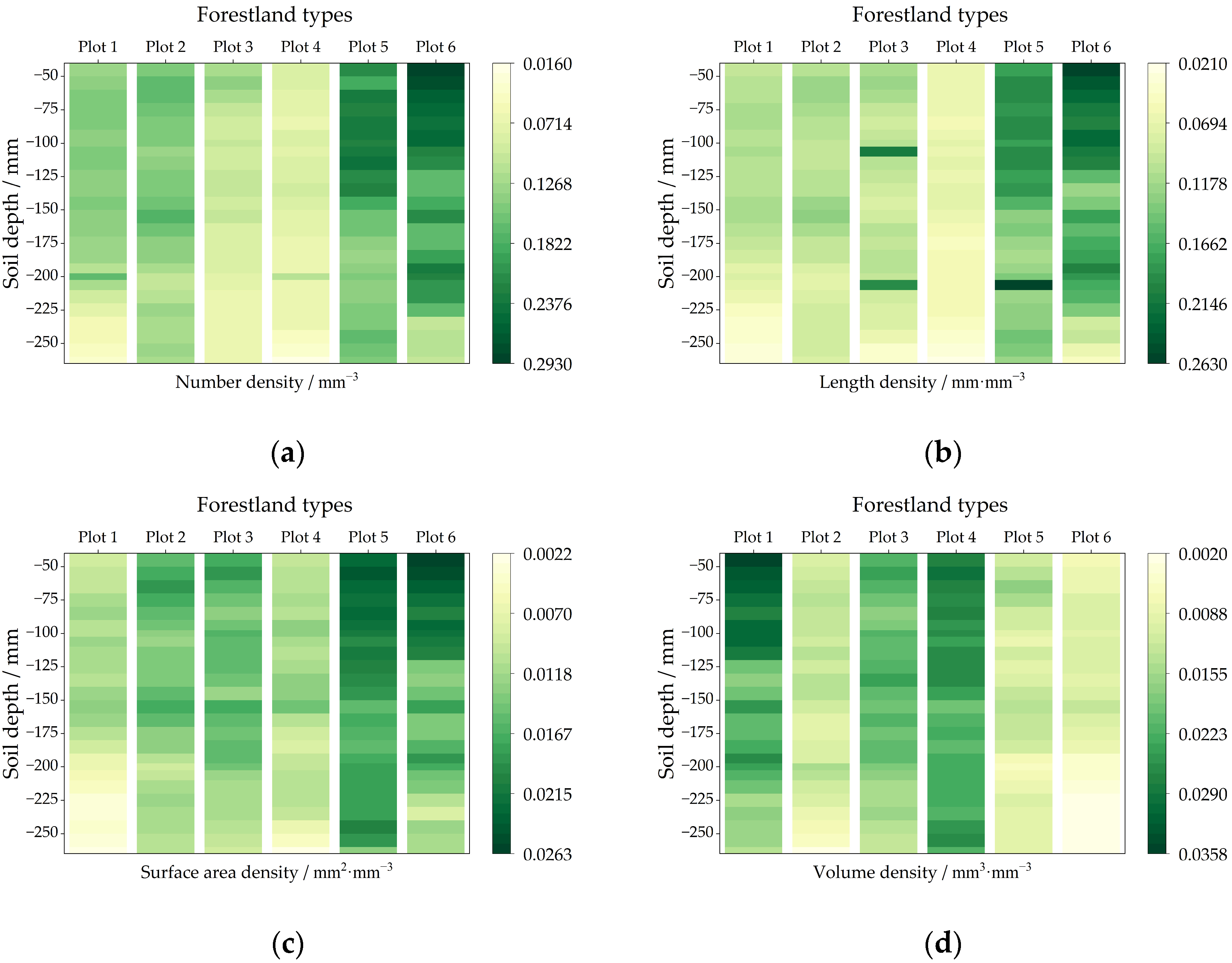

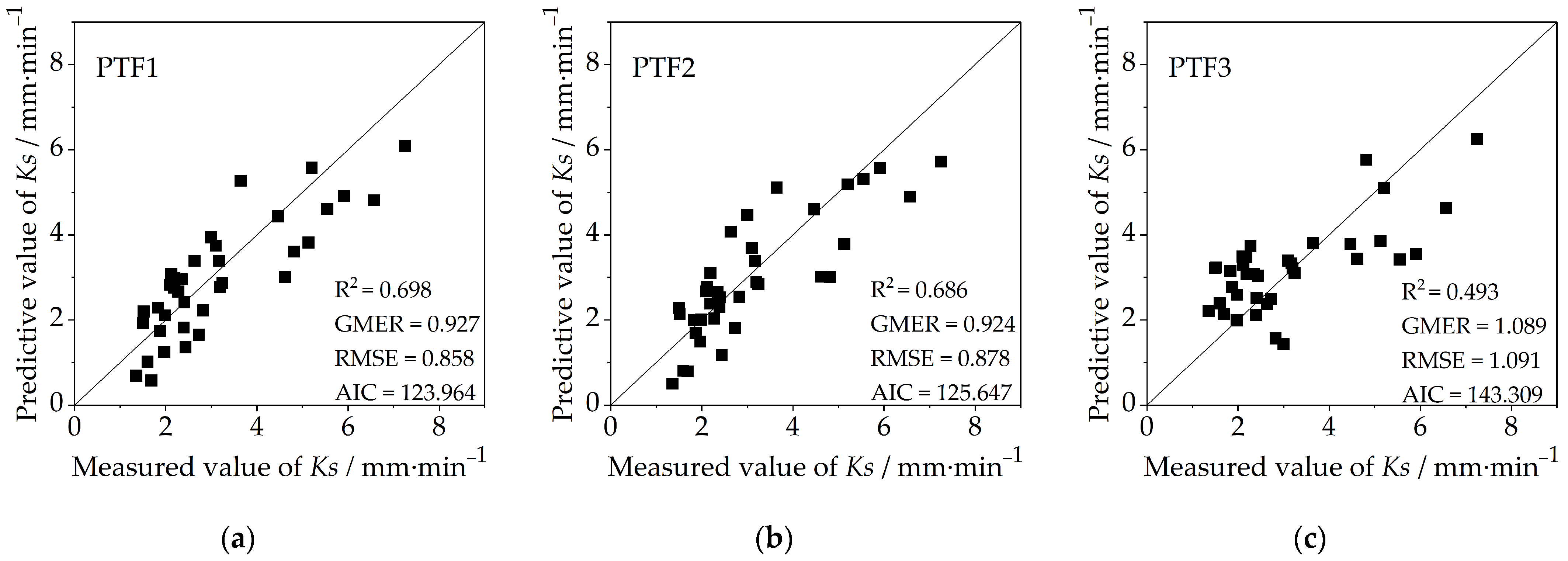

| Experimental Plot | Major Tree Species | Geographical Coordinates | Altitude (m) | Average DBH (cm) | Average Tree Height (m) | Canopy Density | ||
|---|---|---|---|---|---|---|---|---|
| Plot 1 (P) | 0–10 cm | 1–1 | Pure forest of Pinus tabulaeformis Carrière | 40°30′49.56″ N, 116°50′15.70″ E | 217 | 24.46 | 11.25 | 0.85 |
| 10–20 cm | 1–2 | |||||||
| 20–30 cm | 1–3 | |||||||
| Plot 2 (C) | 0–10 cm | 2–1 | Pure forest of Castanea mollissima Blume | 40°30′26.95″ N, 116°49′02.02″ E | 219 | 28.34 | 8.64 | 0.80 |
| 10–20 cm | 2–2 | |||||||
| 20–30 cm | 2–3 | |||||||
| Plot 3 (U) | 0–10 cm | 3–1 | Pure forest of Ulmus pumila L. | 40°30′09.61″ N, 116°48′46.30″ E | 225 | 16.58 | 12.63 | 0.85 |
| 10–20 cm | 3–2 | |||||||
| 20–30 cm | 3–3 | |||||||
| Plot 4 (J) | 0–10 cm | 4–1 | Pure forest of Juglans regia L. | 40°30′33.72″ N, 116°49′31.41″ E | 218 | 16.73 | 7.54 | 0.80 |
| 10–20 cm | 4–2 | |||||||
| 20–30 cm | 4–3 | |||||||
| Plot 5 (P-C) | 0–10 cm | 5–1 | Mixed forest of Pinus tabulaeformis Carrière - Castanea mollissima Blume | 40°30′26.40″ N, 116°49′13.66″ E | 227 | 25.63 | 10.29 | 0.90 |
| 10–20 cm | 5–2 | |||||||
| 20–30 cm | 5–3 | |||||||
| Plot 6 (P-C-U) | 0–10 cm | 6–1 | Mixed forest of Pinus tabulaeformis Carrière - Castanea mollissima Blume - Ulmus pumila L. | 40°30′42.66″ N, 116°49′50.78″ E | 225 | 22.84 | 11.91 | 0.90 |
| 10–20 cm | 6–2 | |||||||
| 20–30 cm | 6–3 | |||||||
| Parameter | Ks | Bulk Density | Water Content | Sand | Silt | Organic Matter | Total Nitrogen | Total Phosphorus | Total Potassium |
|---|---|---|---|---|---|---|---|---|---|
| Forest type | 8.438 ** | 6.943 ** | 13.165 ** | 88.626 ** | 88.604 ** | 22.647 ** | 13.122 ** | 2.523 * | 20.654 ** |
| Soil depth | 8.048 ** | 8.120 * | 3.282 * | 0.871 | 0.875 | 23.301 ** | 21.612 ** | 4.158 * | 26.354 ** |
| Forest type × Soil depth | 7.708 ** | 5.183 ** | 9.727 ** | 112.737 ** | 112.751 ** | 350.879 ** | 29.434 ** | 17.167 ** | 76.793 ** |
| PTFs | Regression | R2 | Significance Level (p) |
|---|---|---|---|
| PTF1 | 0.887 | <0.01 | |
| PTF2 | 0.844 | <0.01 | |
| PTF3 | 0.493 | <0.01 |
| PTFs | Empirical PTF Expressions |
|---|---|
| Cosby | |
| Campbell | |
| Vereecken | |
| Julià |
Disclaimer/Publisher’s Note: The statements, opinions and data contained in all publications are solely those of the individual author(s) and contributor(s) and not of MDPI and/or the editor(s). MDPI and/or the editor(s) disclaim responsibility for any injury to people or property resulting from any ideas, methods, instructions or products referred to in the content. |
© 2023 by the authors. Licensee MDPI, Basel, Switzerland. This article is an open access article distributed under the terms and conditions of the Creative Commons Attribution (CC BY) license (https://creativecommons.org/licenses/by/4.0/).
Share and Cite
Wang, D.; Niu, J.; Miao, Y.; Yang, T.; Berndtsson, R. Predicting Soil Saturated Water Conductivity Using Pedo-Transfer Functions for Rocky Mountain Forests in Northern China. Forests 2023, 14, 1097. https://doi.org/10.3390/f14061097
Wang D, Niu J, Miao Y, Yang T, Berndtsson R. Predicting Soil Saturated Water Conductivity Using Pedo-Transfer Functions for Rocky Mountain Forests in Northern China. Forests. 2023; 14(6):1097. https://doi.org/10.3390/f14061097
Chicago/Turabian StyleWang, Di, Jianzhi Niu, Yubo Miao, Tao Yang, and Ronny Berndtsson. 2023. "Predicting Soil Saturated Water Conductivity Using Pedo-Transfer Functions for Rocky Mountain Forests in Northern China" Forests 14, no. 6: 1097. https://doi.org/10.3390/f14061097





